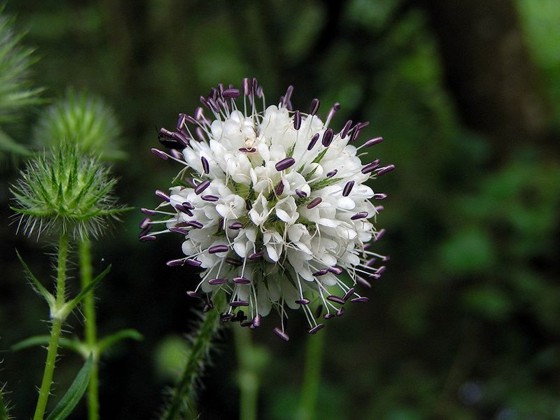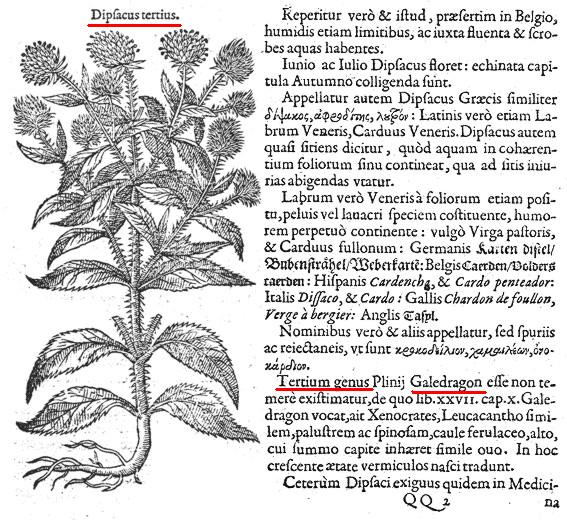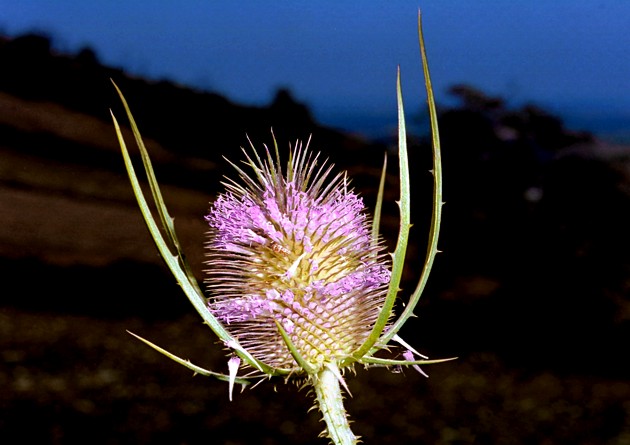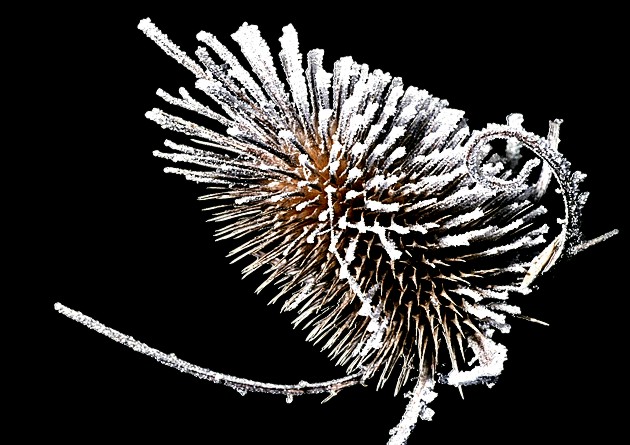Lessico
Dipsacus pilosus
Scardaccione peloso

Cardère
velue
Ordre Dipsacales - Famille Dipsacaceae
La Cardère velue ou Cardère poilue (Dipsacus pilosus L. 1753) est une espèce de plante de la famille des Dipsacaceae. Elle est aussi appelée « Verge à pasteur ». Son feuillage est en rosette la première année, à tige fleurie l'année suivante. Les feuilles sont alors poilues, courtement pétiolées, généralement divisées en 3 segments inégaux, plus ou moins dentés, les latéraux petits en forme d'oreillettes. La tige est rigide, haute de 70 à 150 cm, pourvue d'aiguillons plus ou moins piquants, parsemée de soies et généralement rameuse.
Ses fleurs sont blanches, en capitules subsphériques longs de 1,5-2,5 cm, à corolle en tube (5 à 7 mm) terminé par quatre lobes courts à quatre étamines saillantes. Elle croît en lieux humides: forêts ouvertes, haies, bords de rivière, bords des chemins, décombres. Elle fleurit de juin à septembre et est biennale.

Stirpium
historiae pemptades sex - 1583
di Rembert Dodoens![]()
Dipsacus

Dipsacus
fullonum silvestris
foto di Elio Corti - 1972
Dipsacus is a genus of flowering plant in the family Dipsacaceae. The members of this genus are known as teasel or teazel or teazle. The genus includes about 15 species of tall herbaceous biennial plants (rarely short-lived perennial plants) growing to 1-2.5 m tall, native to Europe, Asia and northern Africa. The genus name is derived from the word for thirst (in Greek dipsáø = I have thirst) and refers to the cup-like formation made where sessile leaves merge at the stem. Rain water can collect in this receptacle; this may perform the function of preventing sap-sucking insects such as aphids from climbing the stem. The leaf shape is lanceolate, 20-40 cm long and 3-6 cm broad, with a row of small spines on the underside of the midrib.
Teasels are easily identified with their prickly stem and leaves, and the inflorescence of purple, dark pink or lavender flowers that form a head on the end of the stem(s). The inflorescence is ovoid, 4-10 cm long and 3-5 cm broad, with a basal whorl of spiny bracts. The first flowers begin opening in a belt around the middle of the spherical or oval flowerhead, and then open sequentially toward the top and bottom, forming two narrow belts as the flowering progresses. The dried head persists afterwards, with the small (4-6 mm) seeds maturing in mid autumn. The seeds are an important winter food resource for some birds, notably the European Goldfinch; teasels are often grown in gardens and encouraged on nature reserves to attract them.
Selected
Dipsacus species:
Dipsacus ferox - Spiny Teasel
Dipsacus fullonum - Wild Teasel, Common Teasel, Fuller's Teasel
Dipsacus japonica - Japanese Teasel, Chinese Teasel
Dipsacus laciniatus - Cut-leaf Teasel
Dipsacus pilosus - Small Teasel
Dipsacus sativus - Fuller's Teasel (cultivated form)
Dipsacus strigosus - Slim Teasel
The Fuller's Teasel (the cultivar group Dipsacus fullonum Sativus Group; syn. Dipsacus sativus) was formerly widely used in textile processing, providing a natural comb for cleaning, aligning and raising the nap on fabrics, particularly wool. It differs from the wild type in having stouter, somewhat recurved spines on the seed heads. The dried flower heads were attached to spindles, wheels, or cylinders, sometimes called teasel frames, to raise the nap on fabrics (that is, to tease the fibers). By the 20th century, teasels were largely replaced by metal cards, which could be made uniform and do not require constant replacement as the teasel heads wear. However, some people who weave wool still prefer to use teasels for raising the nap, claiming that the result is better; in particular, if a teasel meets serious resistance in the fabric, it will break, whereas a metal tool would rip the cloth.
Teasels are also occasionally grown as ornamental plants, and the dried heads are used in floristry. Teasels have been naturalised in many regions away from their native range, partly due to the import of Fuller's Teasel for textile processing, and partly by the seed being a contaminant mixed with crop seeds. Teasel (Dipsacus sylvestris) and Cut-leaved Teasel (Dipsacus laciniatus) have both been observed as invasive species in the United States. Common is more widespread, but Cut-Leaved is more aggressive. A number of medicinal properties claimed for the teasel, though not proven in medical trials.

Dipsacus
fullonum silvestris
foto di Elio Corti - 1972